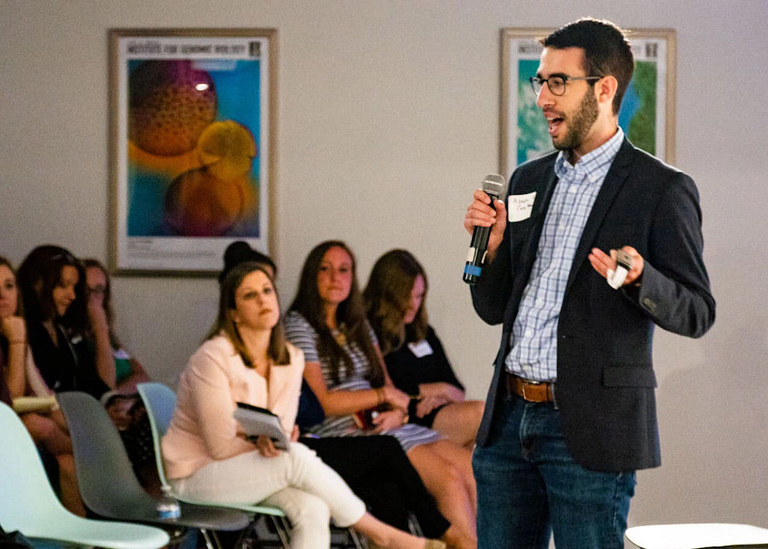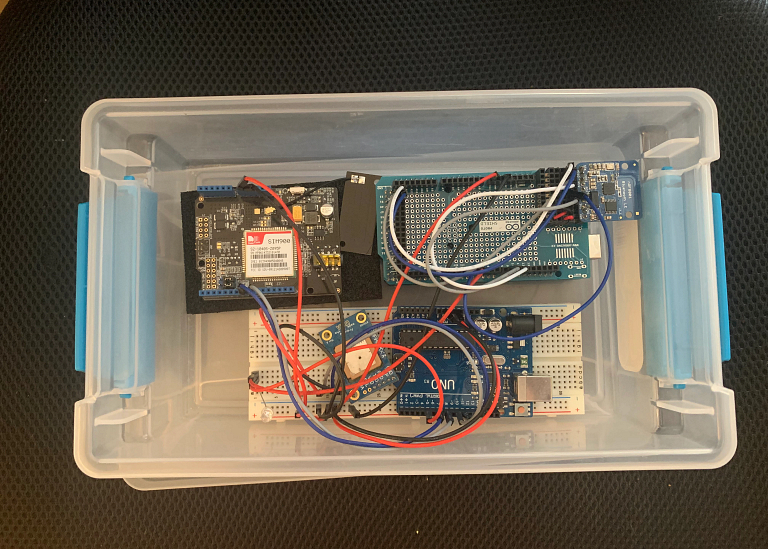
Five years ago, Adam Sobol was a master’s student in information systems at the Indiana University Kelley School of Business with a nascent tech company called CareBand. Now, the IU alum’s startup is keeping company with one of Silicon Valley’s biggest names as a pilot partner with Amazon Sidewalk.
But what propelled a small, Chicago-based health care technology company whose product used a largely unknown wireless technology to power a safety monitor for people with dementia into the tech industry firmament?
A strong product, a confident pitch, a first-mover advantage – and a little help along the way from IU.
Getting started
The first step on Sobol’s path to success was his company’s win in the 2015-16 BEST Competition. Winners of the “Shark Tank”-style pitch competition for student entrepreneurs at Kelley and the then-IU School of Informatics and Computing received $100,000 in venture capital, as well as mentorship from prominent alumni from the world of technology. IU continued to play a role in the company’s growth, even after Sobol’s graduation, through access to the university’s vast array of health care, research and business expertise.
A user-friendly, smart-watch-like device, CareBand provides safety functions such as wander detection, alerts to changes in health and activity monitoring for older adults living with dementia. But the product’s underlying technology sets it apart from other similar products.
How it works
Most notably, CareBand is one of the earliest adopters of LoRa technology, a low-power, long-range network technology. The use of the tech is CareBand’s “first-mover advantage” since it means that the product, as a part of Amazon Sidewalk, can connect to the broad, public wireless network generated by Amazon devices such as Echoes or Ring security cameras, which are both ubiquitous in communities across the country.

“We’re the first company to ever use LoRa technology in a wearable like this,” said Sobol, who also holds an undergraduate degree from the IU Luddy School of Informatics, Computing and Engineering.
This function expands the types of places that CareBand can work reliably, opening them up to use in the home, not just in institutional settings – such as assisted-living communities and long-term care facilities – where they’re currently used. If an older adult wearing a CareBand wanders out of the home, a caregiver can get an immediate notification and their precise location, so long as they reside in a neighborhood with enough of these Sidewalk-enabled devices.
The potential of LoRa has intrigued Sobol since the early 2010s, he said, despite the technology being “under the radar” for years. It’s been a part of CareBand since the first prototype, which wasn’t much more than a pile of wires and circuit boards in a plastic container created in a dorm room in 2015.
“Our goal has always been to get this technology into the home,” said Sobol, whose work was inspired by his father, a board-certified, nationally recognized geriatrician. “He made me think about the potential of this technology for older adults. So much of the tech industry’s energy is focused on software products; I realized there was a lot of potential to do some good with an Internet of Things-based device that is reliable and easy to use.”
That’s another distinction from commercial wearables: CareBand isn’t trying to be “everything to everyone,” Sobol said. The company instead focuses on performing a few important functions in a robust and reliable way – critical qualities in the health care field.
Help from partners
“There’s really a need for this technology in the area of aging in place and elder care,” said Kay Connelly, a professor and associate dean for research at the Luddy School, who worked with Sobol as part of a study with the IU Center for Rural Engagement in 2019. “Traditional wearable devices are fantastic for older adults who are largely independent, but there’s a gap when it comes to older adults who need assistance due to declines in cognitive function. CareBand doesn’t require – or even enable – older adults to interact with it beyond wearing it. The data it collects is used solely by caregivers and family members to ensure older adults are safe.”

Sobol’s partnership with Connelly, which put CareBand in the hands of 20 rural Indiana residents with dementia, helped confirm the feasibility of CareBand in noninstitutional settings, a prelude to the Amazon pilot partnership’s focus on in-home use.
CareBand is also working with researchers at the IU School of Medicine and IU-affiliated Regenstrief Institute to explore the potential of CareBand to detect agitation. Supported by the National Institutes of Health’s Phase I Small Business Innovation Research fund, the study will explore whether CareBand’s wearables can provide caregivers an “early-warning system” to predict agitation and de-escalate stressful situations, preventing the need for psychotropic medications or, in some cases, hospitalization.
IU collaborators on the research are Dr. Ellen Kaehr, an assistant professor of clinical medicine at the IU School of Medicine, and Dr. Daniel Bateman, an assistant professor of psychiatry at the IU School of Medicine and an affiliate scientist at the Regenstrief Institute. Also participating in the study are researchers at the KITE-Toronto Rehabilitation Institute in Canada.
Making connections
Sobol said his first research collaboration with IU was born from a “cold call.” After learning of Connelly’s role as a member of IU’s Proactive Health Lab, he reached out because he thought her research interests might align with his product’s goals.
It wasn’t the last time a direct approach would produce results; CareBand’s pilot partnership with Amazon also arose from a bold pitch to company leadership.

“I had been following the news about Amazon’s Sidewalk program because of its use of LoRa technology,” he said. “After they announced the program, I used LinkedIn to find the name of someone who worked on the project and sent them a message.”
The reply inviting him to “get on a call” came surprisingly fast.
“We realized pretty quickly that our missions were aligned,” he said.
That resourceful approach doesn’t surprise Sobol’s former professors at IU.
“I have been working with student entrepreneurs for over two decades, and, during that time, I have built a ‘hall of fame’ of company founders based on their respective strengths,” said Travis Brown, a senior executive assistant dean and director of the Shoemaker Innovation Center at the Luddy School. “Adam is the most resourceful student entrepreneur I have encountered given his ability to build lean yet robust operations which are sustainable.”
In fact, Brown recently invited Sobol to give back to the entrepreneur community as a member of the advisory board for the Shoebox Fund, which helps IU students make their startup ambitions a reality in a manner similar to the BEST Competition.
Looking ahead, Sobol said, CareBand has established a new brand called Third Wave focused on expanding uses of its core technology – such as workplace safety to lost pet tracking – while staying true to its mission of helping older adults stay safe while aging in place.
“Working with Amazon, it’s got a way of opening new doors,” Sobol said.

